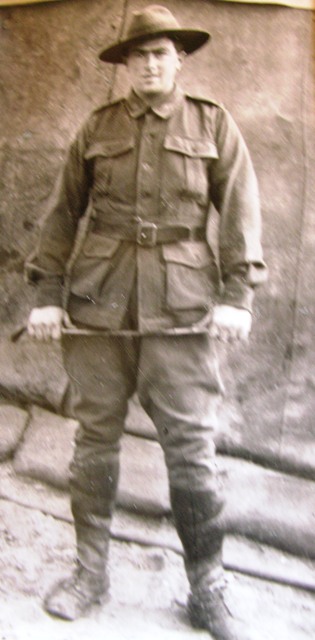L/Cpl
Walter John Bleazard
Information about birth
|
Year of birth: 1895 |
|
Place of birth: Maitland, New South Wales, Australia |
General information
|
Profession: Painter |
|
Religion: Methodist |
Army information
|
Country: Australia |
|
Force: Australian Imperial Force |
|
Rank: Lance Corporal |
|
Service number: 988 |
|
Enlistment date: 19/10/1914 |
|
Enlistment place: Broadmeadows, Victoria, Australia, Australia |
|
Units: — 4th Australian Field Ambulance (Last known unit) |
Information about death
|
Date of death: 28/10/1917 |
|
Place of death: Lijssenthoek, Remy Siding Casualty Clearing Stations, Belgium |
|
Cause of death: Died of wounds (D.O.W.) |
|
Age: 22 |
Cemetery
|
Lijssenthoek Military Cemetery Plot: XXII Row: H Grave: 13A |
Distinctions and medals 3
|
1914-15 Star Medal |
|
British War Medal Medal |
|
Victory Medal Medal |
Points of interest 4
| #1 | Place of birth | ||
| #2 | Enlistment place | ||
| #3 | Place of wounding | ||
| #4 | Place of death (approximate) |
My story
Walter John Bleazard was born in Maitland, New South Wales, the son of Mary Ann Eliza Pullen and John Bleazard. He joined the Australian Imperial Force on 19 October 1914 in Broadmeadows, Victoria. He then worked as a painter. Walter was posted to the 4th Field Ambulance. He served at Gallipoli, where he fell ill several times. He remained with this unit when the Australian Imperial Force went to France in 1916.
In late 1917, Australian divisions fought in various parts of the 3rd Battle of Ypres - the Battle of Menin Road Ridge, the Battle of Polygon Wood, the Battle of Broodseinde and the First Battle of Passchendaele. On 11 October, the stretcher-bearers section of 4th Field Ambulance was attached to 13th Field Ambulance in the Zonnebeke area. On 12 October the First Battle of Passchendaele began, resulting in very heavy losses. In addition to the reinforced 13th Field Ambulance, 150 men from 15th Battalion Australian Imperial Force were placed as temporary carriers. Dispositions of stretcher bearers at Zonnebeke on 12 October refer to Cordial Factory, St Joseph's Institute and Railway Dump. A sketch map refers to 'Soda Water Factory' instead of Cordial Factory.
Walter Bleazard was severely wounded with gunshot wounds to the face, chest and left arm on 20 October 1917. He was recovered by the 3rd Australian Field Ambulance. On 28 October he died at the 17th Casualty Clearing Station, then stationed at Remy Siding near Poperinge. On 23 October, the men of the 4th Field Ambulance rejoined their unit. An extract from unknown source provided by Greg Bleazard refers to several places in the vicinity of Zonnebeke. 'Cordial Factory RAP' (also known as Soda water factory, and a brewery) stood on the road from Zonnebeke church to the railway station (Langemarkstraart), approximately where the large white house on Langemarkstraart 12 now stands. 'St Josephs Convent' is St Joseph's school (or institute) - on the south side of Ieperstraart, just east of the junction with Kleine Molenstraart. Both buildings were destroyed during the war. A third reference, to 'Dooley's Farm', cannot be found.
Walter Bleazard was buried in the Lijssenthoek military cemetery, next to the 17th Casualty Clearing Station. His personal effects were returned to Australia, but were lost when the troopship Barunga was torpedoed on 15 July 1918, 150 miles off Land's End, Britain.
In late 1917, Australian divisions fought in various parts of the 3rd Battle of Ypres - the Battle of Menin Road Ridge, the Battle of Polygon Wood, the Battle of Broodseinde and the First Battle of Passchendaele. On 11 October, the stretcher-bearers section of 4th Field Ambulance was attached to 13th Field Ambulance in the Zonnebeke area. On 12 October the First Battle of Passchendaele began, resulting in very heavy losses. In addition to the reinforced 13th Field Ambulance, 150 men from 15th Battalion Australian Imperial Force were placed as temporary carriers. Dispositions of stretcher bearers at Zonnebeke on 12 October refer to Cordial Factory, St Joseph's Institute and Railway Dump. A sketch map refers to 'Soda Water Factory' instead of Cordial Factory.
Walter Bleazard was severely wounded with gunshot wounds to the face, chest and left arm on 20 October 1917. He was recovered by the 3rd Australian Field Ambulance. On 28 October he died at the 17th Casualty Clearing Station, then stationed at Remy Siding near Poperinge. On 23 October, the men of the 4th Field Ambulance rejoined their unit. An extract from unknown source provided by Greg Bleazard refers to several places in the vicinity of Zonnebeke. 'Cordial Factory RAP' (also known as Soda water factory, and a brewery) stood on the road from Zonnebeke church to the railway station (Langemarkstraart), approximately where the large white house on Langemarkstraart 12 now stands. 'St Josephs Convent' is St Joseph's school (or institute) - on the south side of Ieperstraart, just east of the junction with Kleine Molenstraart. Both buildings were destroyed during the war. A third reference, to 'Dooley's Farm', cannot be found.
Walter Bleazard was buried in the Lijssenthoek military cemetery, next to the 17th Casualty Clearing Station. His personal effects were returned to Australia, but were lost when the troopship Barunga was torpedoed on 15 July 1918, 150 miles off Land's End, Britain.
Sources 3
|
13th Australian Field Ambulance, (Australian War Memorial, Campbell (AWM), AWM4 26/56/19). https://www.awm.gov.au Sources used |
|
4th Australian Field Ambulance, (Australian War Memorial, Campbell (AWM), AWM4 26/47/25). https://www.awm.gov.au/ Sources used |
|
First Australian Imperial Force Personnel Dossiers, 1914-1920 (National Archives of Australia, Canberra (NAA), B2455). https://www.naa.gov.au/ Sources used |
More information 4
|
The AIF Project (UNSW Canberra) https://aif.adfa.edu.au/showPerson?pid=25089 |
|
Commonwealth War Graves Commission Database https://www.cwgc.org/find-records/find-war-dead/casualty-details/430888 |
|
Namenlijst (In Flanders Fields Museum) https://namenlijst.org/publicsearch/#/person/_id=34301bcd-65a7-4ebc-8f96-e9f34881a9f2 |
|
Lives of the First World War (Imperial War Museum) https://livesofthefirstworldwar.iwm.org.uk/lifestory/7362022 |
